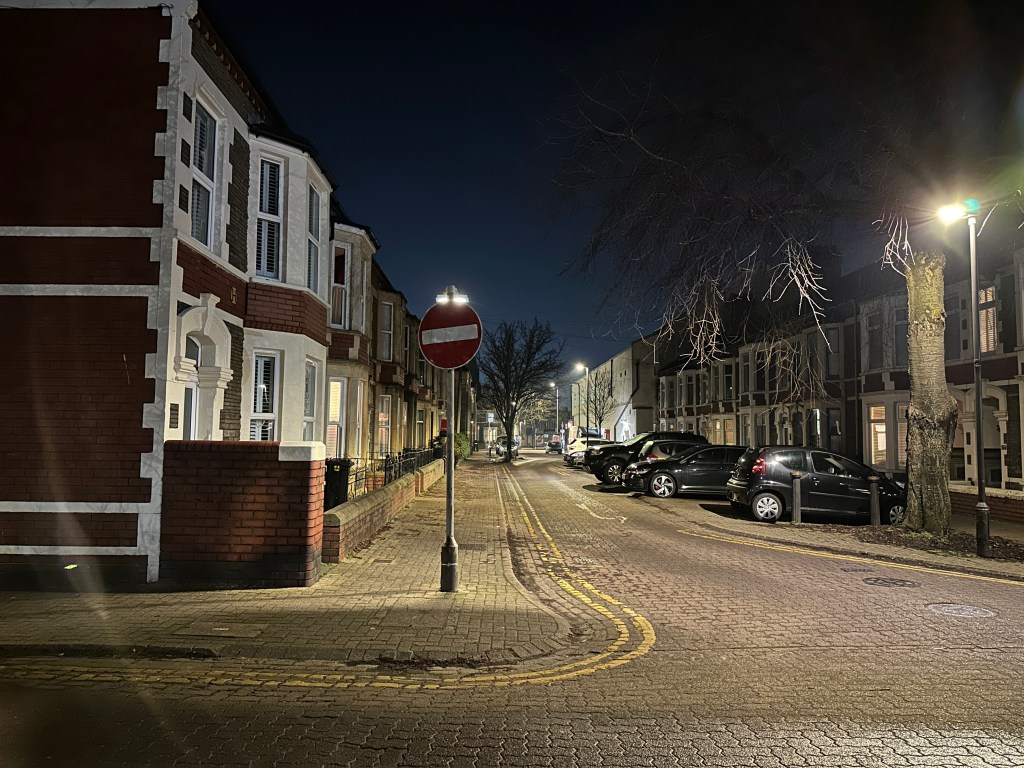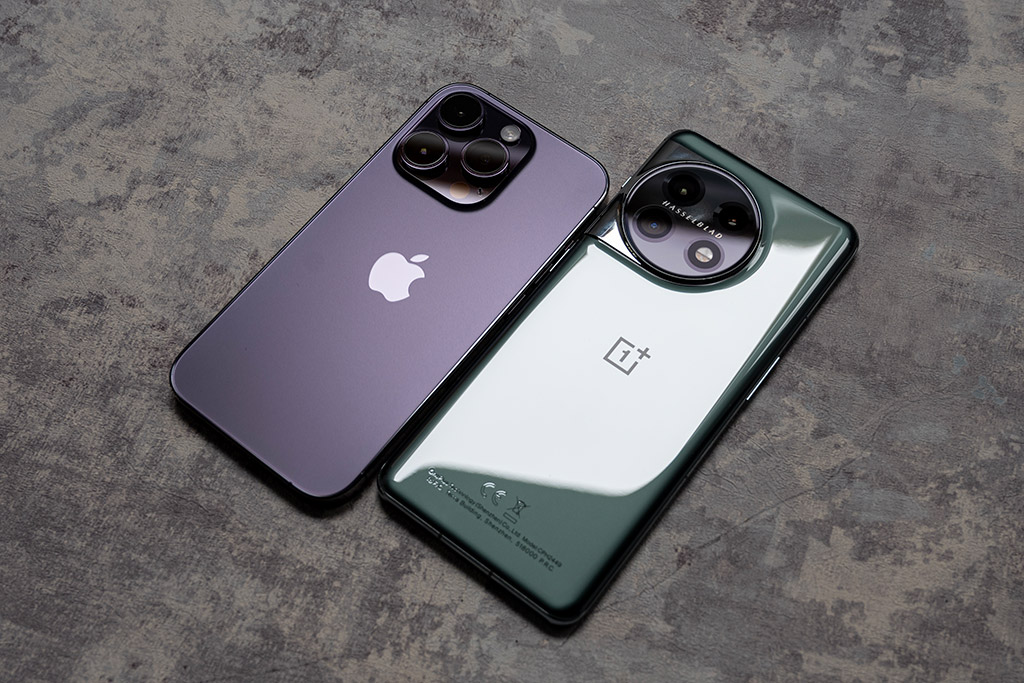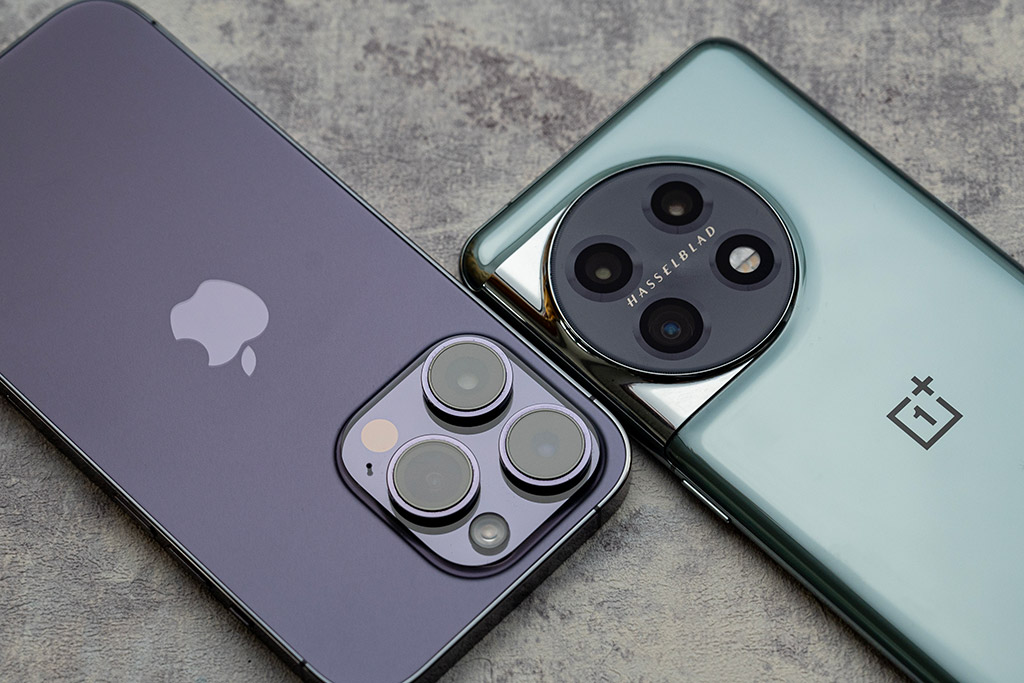Amy Davies pits the iPhone 14 Pro vs OnePlus 11 to find out which is the best camera phone for photographers. Does the budget Android phone have what it takes? Or is Apple’s flagship the best choice?
Camera quality has become a major consideration when we choose a smartphone. Most of us now snap a photo with ours at least once per day! Many professional content creators work entirely on their smartphones nowadays, relying on their clever little devices to produce high-quality images and videos.
A big part of the enormous popularity of Apple’s iPhones is the camera quality. Their current flagship, the iPhone 14 Pro, is the best yet. However, as anyone who has browsed Apple products knows, it inevitably commands a high price. Correspondingly, many compelling budget alternatives have sprung up for the cash-conscious among us. One is the excellent OnePlus 11. Running on Android, this phone offers 8K video and Hasselblad-made lenses, at a price significantly cheaper than that of the iPhone 14 Pro.
You can read our full OnePlus 11 review and our iPhone 14 Pro review for more details on each phone. For those deciding on camera alone, we have called both phones in for a side-by-side test and shootout.
There are plenty of considerations we all make when we buy a smartphone. To properly assess a phone’s camera quality demands testing its performance in disparate situations; the specialist modes it offers; and how well they work.
As such, we’ve attempted to provide a comprehensive overview of the various strengths and weaknesses of the iPhone 14 Pro and the OnePlus 11, and how they compare with one another in a variety of areas. Here are the key categories we’ve looked at.
Camera specs: First things first, we look at the respective camera arrays these two powerful phones are packing. Megapixel counts, lens focal lengths and apertures, zoom capability – here we lay it all out before putting the manufacturer claims to the test.
Camera apps and shooting modes: A run-through of the different shooting modes the two phones offer through their native camera apps. These include manual modes where the user can take control of exposure settings, as well as specialist shooting modes like Night and Macro.
General image quality: We place images from the two phones’ cameras side by side for a detailed picture (pun intended!) of how well they perform. We compare colour reproduction and zoom capability to get a sense of how the phones are for day-to-day shooting.
Low light: Smartphone cameras used to suffer greatly in low light, but clever computational tricks and stabilisation tech has led to a vast improvement in Night Mode shooting on flagship phones. We take the iPhone 14 Pro and OnePlus 11 out after dark to see how they fare.
Macro: Another area where smartphones have vastly improved in recent generations, close-up photography, is achieved by both the iPhone 14 Pro and the OnePlus 11. Both phones automatically switch to their ultra-wide lens when they get close to a subject. We compare the close-ups to see which phone does detail the best.
Portrait: The OnePlus 11 was launched in a blitz of hype about its portrait-shooting capabilities, while Apple has been quietly refining the Portrait Modes on its flagship phones for years. We see how the two phones perform when it comes to capturing people pictures.
Video: The OnePlus 11 offers a headline feature of 8K resolution, but do many users actually need it? And is the iPhone’s 4K more than good enough to get the job done?
Screen and design: How a phone looks and feels is a hugely important consideration when deciding what to buy. It doesn’t matter how sophisticated a phone’s camera array is if you don’t like the way images look on its display, or it’s too small (or too large) for you to comfortably use. We compare the physical properties of the iPhone 14 Pro and the OnePlus 11, as well as looking at screen resolution.
Battery life and capacity: Smartphone batteries have improved in recent years as users have grown less and less tolerant of owning a phone that can’t make it through a full day. Both the iPhone 14 Pro and the OnePlus 11 make some big promises when it comes to battery life – here’s how they actually stack up.
Price: Finally, we compare the price tags of the two phones (no prizes for guessing which one’s cheaper) and look at what they offer for the money the manufacturers are asking.
Ultimately, a decision in choosing between cellphones may depend on broader factors than the camera, so over to you to weigh them. This guide aims to illuminate the respective cameras only, and other factors only so far as they affect their use ie design. For more budget options for smartphone photography, check out our full guide to the best budget camera phones – For now, back to iPhone 14 Pro vs OnePlus 11.
iPhone 14 Pro vs OnePlus 11: Camera Specs
It’s no surprise these days to see triple-lens setups on the back of cameras, and we get them with both of these. Note that the iPhone 14 Pro can also be bought in the larger ‘Max’ size, but the camera specification remains the same between the two – see the section regarding screen and price for more on the Max.
Both smartphones have an ultra-wide, a standard and a zoom lens. With the OnePlus 11 you get a 14mm (f/2.2), 24mm (f/1.8) and 48mm (f/2.0) equivalents, while the iPhone 14 Pro gives you a little bit longer to work with, with 13mm (f/2.2), 26mm (f/1.78) and 78mm (f/2.8) lenses. OnePlus says that its gone for a relatively short zoom lens to enable users to concentrate on portraits rather than distant subjects. With the iPhone, you also get a 2x digital option selectable from the main screen. With both phones, there is digital zoom available – up to 20x with the OnePlus and 15x with the iPhone.
Regarding resolution, the OnePlus has a 50MP main camera, with the iPhone 14 Pro close to it with a 48MP device. You get far more resolution with the OnePlus secondary cameras than with the iPhone. The ultra-wide has a 48MP sensor, while the 2x lens has a 32MP sensor. Both of the iPhone’s additional camera sensors are just 12MP.
On paper at least, it looks as though the OnePlus is the better offering – at least in resolution. We’ll see how that transpires in the real world as we go through the test.
iPhone 14 Pro vs OnePlus 11: Camera apps and shooting modes
The OnePlus 11 offers a more comprehensive set of options in the native camera app. As well as the usual normal shooting mode for stills and videos, there’s also a set of additional options initially hidden under a ‘More’ tab. Here you’ll find a manual mode which gives you the option to change shooting parameters such as shutter speed, ISO, white balance and so on. This is not in the iPhone’s native camera app. Several third-party apps exist to fulfil the extra functions.
Both phones offer the typical modes we’re used to on modern smartphones. One is a Portrait mode for creating shallow depth of field effects. With the OnePlus, this has been designed in collaboration with Hasselblad and is designed to emulate the look of classic Hasselblad lenses.
Each phone also a Night mode, but the iPhone’s is automatically activated when low light levels are detected. Both have macro shooting, and are automatic when the phone detects its proximity to a subject. Similarly, each switches to the ultra-wide lens to carry out macro shooting.
Raw format shooting is available with both models, though note that with the OnePlus it’s only accessible shooting in the “Pro” mode. With the iPhone, it’s only through shooting in raw format (available in the standard Photo mode) that you can record in the full 48 megapixels – otherwise images are always output at 12MP.
With the OnePlus, images are usually output at 12MP, but “High Res” mode in the standard Photo option can be selected.
iPhone 14 Pro vs OnePlus 11: General image quality
Comparing images from each smartphone side by side, the image quality is very close, especially from shooting in good light.
Both of them easily produce nicely detailed images with good, realistic colours. It’s difficult to set them apart in many scenarios. One, though, is in the colour differences between the lenses – we detect marked variance between the colours produced by the three OnePlus lenses, while the iPhone’s are much better matched. The disparity with the OnePlus is particularly noticeable when photographing in artificial light, and can sometimes also be seen in skies.
As the iPhone has a longer lens, then we get slightly better zooming options. The 2x digital option produces excellent results that almost make it feel that there are four lenses available.
The differences between the two smartphones are perhaps easier to recognise if we look at specific subjects, as below.
Low light
Both of the smartphones put in an excellent performance in low light. Very little sets them apart in the scene we photographed, but the OnePlus edges it for the overall impression of detail and balanced exposure; especially regarding finer details. That said, there’s worse flare with the OnePlus example, which degrades the quality of the image a little.
The iPhone 14 Pro also has a longer lens than the OnePlus 11, so if you do a lot of low light work and think you’ll need that extra reach, then the iPhone is better suited for you – otherwise this is a very close call indeed.
Macro
You can shoot close-ups with both the iPhone 14 Pro and the OnePlus 11, with the camera app automatically switching to the ultra wide angle lens when it detects you’ve got close to a subject.
Again, the differences are subtle upon a cursory look, or viewed on the smartphone screens. However, closer examination reveals some finer detail in the iPhone shot than that of the OnePlus 11.
Portrait
For us, the results did not justify the marketing hyperbole for the prowess of the OnePlus 11’s Portrait mode.
While adequate for viewing the images only on the smartphone screen, zooming in, or transferring an image to a larger screen presents problems with fuzzy outlines.
Meanwhile, the iPhone portraits aren’t perfect – but the overall impression is more favourable, with better colouring (especially in the background) and a softer, more flattering appearance on the face. The outline around the hair is better too.
In general, the iPhone is also better with non-human subjects such as pets, too.
iPhone 14 Pro vs OnePlus 11: Video
Both make strong claims about the quality of their video recording. Only with the OnePlus 11 can you record in 8K – albeit at a heavy crop – for those insistent on this.
For the average person, 4K is likely to be more than they need. Both produce very good 4K video, with the iPhone offering more in the way of stabilisation options, including “Action Mode” for super-smooth video.
The OnePlus has some additional shooting options for video, such as “Film” mode, where you can create VLog material, but the iPhone does offer “ProRes” recording for better colour and less compression.
Both other other typical useful modes, such as slow motion and time-lapse. Only the iPhone 14 Pro has the option to record shallow depth of field video with its Cinematic mode, so that’s something to think about.
iPhone 14 Pro vs OnePlus 11: Screen and Design
You can pick up the iPhone 14 Pro in two different sizes; the choice between a 6.1” screen and a 6.7” screen (iPhone 14 Pro Max). The cameras between the two devices are exactly the same, so it’s good to have a choice of size. The smaller option is more pocket-friendly and easier to use one-handed, while the larger screen shows off your photographs and videos better.
The OnePlus 11 meanwhile only has option available – 6.7”, making it the same as the larger of the two iPhone models. It’s a great screen and shows off your photos very well, but those who like smaller devices may be a bit disappointed.
In terms of resolution, the QHD+ screen of the OnePlus 11, at 3216 x 1440 is higher than the iPhone 14 Pro Max’s Super Retina XDR screen, which is 2796 x 1290 in resolution. The smaller phone offers 2556 x 1179 resolution. Both still look good and without comparison next to a higher resolution device you shouldn’t be disappointed.
The iPhone 14 Pro has a Ceramic Shield front, while the OnePlus 11 uses Corning Gorilla Glass Victus. Both should withstand knocks, scrapes and falls fairly well, but we haven’t tested this to maximum destruction – though we’ve been slinging both in a pocket for several weeks and not noticed any obvious scratches, dints or marks.
One difference here is that the iPhone 14 Pro is IP68 water and dust resistant, while the OnePlus 11 is only IP64. What that means is that although it can resist water splashes, don’t expect to be able to dunk it completely in water (like you can with an iPhone) and for it to survive. Still, for the price difference between the two, this is a pretty fair sacrifice.
In terms of aesthetics, the two models are quite different. The iPhone 14 Pro is boxier, with squared off edges, while the OnePlus 11 is sleeker – and – if you opt for the Emerald version, it’s dazzlingly shiny. Which you prefer is a matter of personal choice though, so it’s difficult to come down objectively on that one.
iPhone 14 Pro vs OnePlus 11: Battery Life and Capacity
Apple doesn’t disclose its exact battery details, but we do know that the iPhone 14 Pro can last 23 hours, or 29 hours for the larger iPhone 14 Pro Max (tested with video playback).
Meanwhile, the OnePlus 11 boasts a 5,000 mAh battery. Whichever metric you want to use to compare, in real-world usage we found that both lasted a full day with relatively normal to heavy use, even when taking quite a few photos and videos.
Both of the phones offer fast charging, with the OnePlus 11 putting in a particularly impressive performance on that front, offering 70% charge in just 15 minutes, or completely full charge in 25 minutes. That’s if you use the 100w charger, which, relatively unusually these days comes in the box with the phone.
Interestingly, there’s no wireless charging for the OnePlus phone – this is apparently because the wired charging is so good, but it’s a shame for anybody who has already invested in wireless charging pads or docks around the house. You can both quick charge and wirelessly charge with the iPhone.
For capacity, you can’t expand storage with either device, so it’s always worth plumping for the most you can afford if you can. There are just two storage options with the OnePlus 11, 256GB or 512GB. Since the 512GB comes with a relatively small price premium, it’s definitely worth spending that little bit extra – you’ll also get more RAM too.
With the iPhone, you’ve got options from 128GB, up to 1TB, with incremental price increases in between each. It’s worth noting that if you opt for the 128GB option, you won’t be able to shoot in 4K in ProRes video mode, since it needs so much memory. Not likely to be a problem for most perhaps, but something to be aware of.
iPhone 14 Pro vs OnePlus 11: Price
The price of the two (three) models is one of the biggest differences for us to examine – and for those who want to save money, looking towards brands like OnePlus is a smart option if you’re happy to move out of the Apple ecosystem.
Let’s start with the OnePlus 11. There’s just two options here, either the 256GB / 8GB RAM setup, or the 512GB / 16GB RAM version. The former costs £729, while for a relatively small bump in price, to £799, you can get the higher capacity, faster model. To us, opting for the slightly more expensive one seems like a bit of a no brainer, but it depends on how tight your budget is.
Meanwhile, the iPhone 14 Pro starts at £1,099, but that’s for the smaller 6.1” option. The better, more direct comparison therefore is with the iPhone 14 Pro Max, which will cost you at least £1,199. For either of those prices, you only get 128GB. So, again to make it fairer, for the 256GB version, you’ll need to spend £1,209 (iPhone 14 Pro), or £1,309 (iPhone 14 Pro Max) for the same screen size as the OnePlus 11.
Essentially, that’s a price difference of close to £600 for like-for-like models – iPhone 14 Pro Max 256GB (£1,309) vs OnePlus 11 256GB (£729)… a pretty hefty saving if you opt for the OnePlus 11.
iPhone 14 Pro vs OnePlus 11: Verdict
It’s impressive how good the OnePlus 11 performs for photography, especially considering the massive disparity in price between it and the iPhone 14 Pro.
While it doesn’t necessarily beat the iPhone in every regard, it comes close in many – and whether you think the better performance from the iPhone is worth the extra cost is likely to be a personal decision.
The general image quality between the two is fairly similar. Macro is slightly better from the iPhone, while low light is just about better from the OnePlus (albeit with flare issues if there are anything like street lamps present). The zooming is better from the iPhone, while the colour disparity between the OnePlus lenses is not ideal.
It is of course also true that many people simply prefer iOS, and no matter how good a cheaper Android is, it’s difficult to move away from that system. Especially if you’ve been using an iPhone for several years and have invested in the overall ecosystem with things like iCloud, MacBooks, iPads and so on.
Overall, it’s clear to see that the iPhone 14 Pro is better. But, crucially, it’s probably not £600 better than the OnePlus 11, making the latter a great option for those on a more limited budget.
Article by Amy Davies, with contributions from Jon Stapley.
Related articles:
iPhone 14 Pro vs iPhone 13 Pro Compared
Samsung S23 Ultra vs iPhone 14 Pro: which smartphone is best for photographers?
iPhone 14 Pro vs Google Pixel 7 Pro – Cameras Compared































